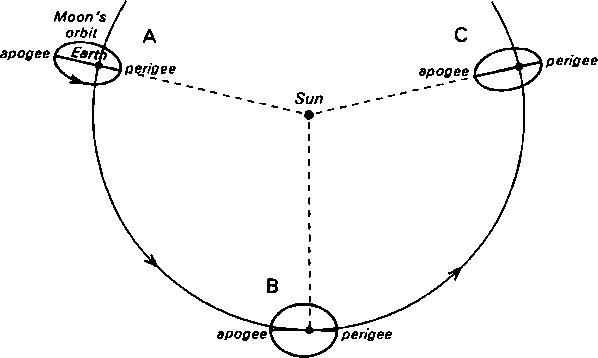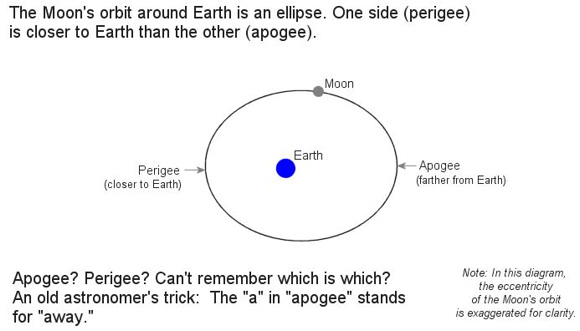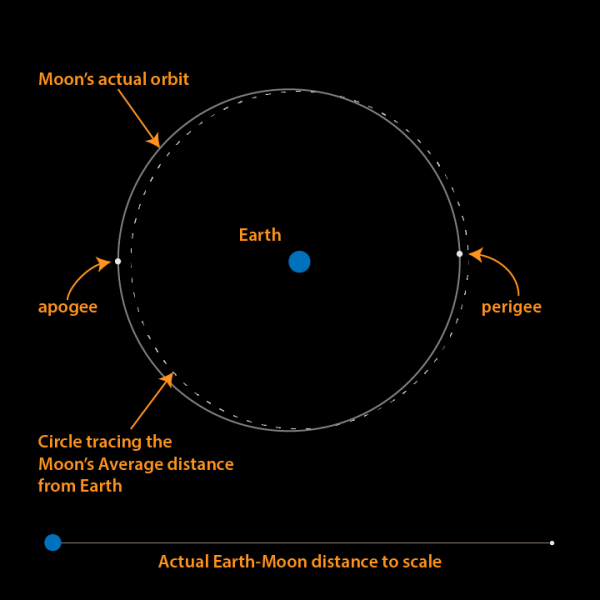
Above: Simulated image of April 25, 2018 moon via the U.S. Naval Observatory
You know the moon changes its distance from Earth continually. It must, since the orbit of the moon is not a perfect circle; instead, it’s an ellipse, like a circle someone sat down on. The moon was last at perigee – its closest point to Earth for this month – on April 20. So on the date of the article you’re reading now – April 25, 2018 – and into early May, the moon’s distance from Earth is steadily increasing. It’ll continue increasing until our companion world reaches apogee – its farthest point for the month – on May 6.
Moon’s distance at April 20 perigee 229,108 miles or 368,714 km
Moon’s distance at May 6 apogee 251,318 miles or 404,457 km
Separation: 22,210 miles or 35,743 km
Tonight’s moon is fairly close to the moon’s mean distance of 238,855 miles (384,400 km).
Click here to find out the moon’s present distance.
Tonight’s moon is also still in the constellation Leo the Lion, as shown on the chart below.

In 2018, the moon sweeps through Leo the Lion for several days, around April 23 to 25. The starlit figure of the Lion is one of our sky’s easiest-to-see patterns, but it’ll be more difficult in the moon’s glare. Pick out bright stars near tonight’s moon – for example, Regulus, Leo’s brightest star – and come back tomorrow night when the moon is a bit farther away.
In 2018, the largest separation between lunar perigee and apogee happened in January.
January 1 closest perigee of 2018 = 221,559 miles or 356,565 km
January 15 farthest apogee of 2018 = 252,565 miles or 406,464 km
Separation: 31,006 miles or 49,899 km
Throughout the year, the separation between perigee and apogee varies from a maximum of about 31,00 miles (50,000 km) to a minimum of approximately 21,000 miles (34,000 km). The illustration below helps to explain why.

Image via Bedford Astronomy Club.
When the moon’s perigee-apogee line points toward the sun, as it does at A and C in the diagram, the moon’s orbit is maximally eccentric (oblong), which means a closer perigee distance yet more distant apogee distance. Hence, that means a larger separation between perigee and apogee. The perigee-apogee line points toward the sun in cycles of about 206 days.
On the other hand, when the moon’s perigee-apogee line makes a right angle with the Earth-sun line, as at B in the diagram, the moon’s eccentricity is at a minimum (closest to circular). That means a farther perigee distance yet closer apogee distance, which mean a minimal separation between perigee and apogee. A to B (or B to C) in the diagram represents a period of about 103 days.

This year’s 14 perigees and 13 apogees via John Walker’s Lunar Perigee and Apogee Calculator,

The moon’s orbit is closer to being a circle than the diagram suggests, but the exaggeration helps to clarify. The moon is closest to Earth in its orbit at perigee and farthest away at apogee. Image via NASA.

This illustration is closer to the actual shape of the moon’s orbit around Earth. It’s not a perfect circle, but it is very nearly circular, as the above diagram shows. Diagram by Brian Koberlein.
Bottom line: The moon was closest to Earth April 20. It’ll be farthest from Earth May 6. The April 25, 2018 moon is closer to its average distance from Earth.
Resources:
Moon at Perigee and Apogee: 2001 to 2100
Lunar Perigee and Apogee Calculator
from EarthSky https://ift.tt/2HsPpZ0

Above: Simulated image of April 25, 2018 moon via the U.S. Naval Observatory
You know the moon changes its distance from Earth continually. It must, since the orbit of the moon is not a perfect circle; instead, it’s an ellipse, like a circle someone sat down on. The moon was last at perigee – its closest point to Earth for this month – on April 20. So on the date of the article you’re reading now – April 25, 2018 – and into early May, the moon’s distance from Earth is steadily increasing. It’ll continue increasing until our companion world reaches apogee – its farthest point for the month – on May 6.
Moon’s distance at April 20 perigee 229,108 miles or 368,714 km
Moon’s distance at May 6 apogee 251,318 miles or 404,457 km
Separation: 22,210 miles or 35,743 km
Tonight’s moon is fairly close to the moon’s mean distance of 238,855 miles (384,400 km).
Click here to find out the moon’s present distance.
Tonight’s moon is also still in the constellation Leo the Lion, as shown on the chart below.

In 2018, the moon sweeps through Leo the Lion for several days, around April 23 to 25. The starlit figure of the Lion is one of our sky’s easiest-to-see patterns, but it’ll be more difficult in the moon’s glare. Pick out bright stars near tonight’s moon – for example, Regulus, Leo’s brightest star – and come back tomorrow night when the moon is a bit farther away.
In 2018, the largest separation between lunar perigee and apogee happened in January.
January 1 closest perigee of 2018 = 221,559 miles or 356,565 km
January 15 farthest apogee of 2018 = 252,565 miles or 406,464 km
Separation: 31,006 miles or 49,899 km
Throughout the year, the separation between perigee and apogee varies from a maximum of about 31,00 miles (50,000 km) to a minimum of approximately 21,000 miles (34,000 km). The illustration below helps to explain why.

Image via Bedford Astronomy Club.
When the moon’s perigee-apogee line points toward the sun, as it does at A and C in the diagram, the moon’s orbit is maximally eccentric (oblong), which means a closer perigee distance yet more distant apogee distance. Hence, that means a larger separation between perigee and apogee. The perigee-apogee line points toward the sun in cycles of about 206 days.
On the other hand, when the moon’s perigee-apogee line makes a right angle with the Earth-sun line, as at B in the diagram, the moon’s eccentricity is at a minimum (closest to circular). That means a farther perigee distance yet closer apogee distance, which mean a minimal separation between perigee and apogee. A to B (or B to C) in the diagram represents a period of about 103 days.

This year’s 14 perigees and 13 apogees via John Walker’s Lunar Perigee and Apogee Calculator,

The moon’s orbit is closer to being a circle than the diagram suggests, but the exaggeration helps to clarify. The moon is closest to Earth in its orbit at perigee and farthest away at apogee. Image via NASA.

This illustration is closer to the actual shape of the moon’s orbit around Earth. It’s not a perfect circle, but it is very nearly circular, as the above diagram shows. Diagram by Brian Koberlein.
Bottom line: The moon was closest to Earth April 20. It’ll be farthest from Earth May 6. The April 25, 2018 moon is closer to its average distance from Earth.
Resources:
Moon at Perigee and Apogee: 2001 to 2100
Lunar Perigee and Apogee Calculator
from EarthSky https://ift.tt/2HsPpZ0

Aucun commentaire:
Enregistrer un commentaire